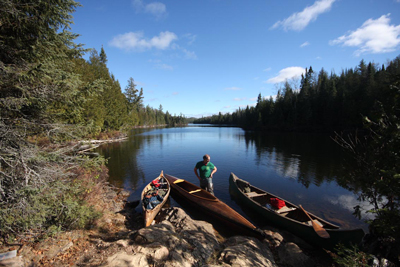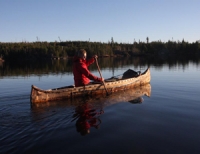This fall I was reminded of the special “firsts” I’ve been privy to at the Center when I had one of my own. It didn’t occur in the city, but the feeling of wonder and connection in nature is universal – no matter where you are.
I’ve been on many wilderness expeditions, but for me this trip to the Boundary Waters Canoe Area Wilderness offered two very special “firsts.” After receiving the invite one “first” was expected, the other was a complete and profound surprise.
My first “first” was using a genuine birch bark canoe as a utility boat. It was light, cut the water well and a joy to handle. It was only 175 years ago that birch bark canoes graced the waters of the Milwaukee, the Menomonee and the Kinnickinnic rivers. They are beautiful boats that had been in use as the primary river transportation in these parts for thousands of years. I’ve seen them in museums and I think I may have touched one once, but never did I dream of actually using one. That is until I received the email inviting me on this trip.
 The cool thing is that we didn’t just “try it out” for half an hour on calm water in the sun, but we used it and abused it for six amazing full weather days way up north in the Boundary Waters, a million acre wilderness area near the Canadian border.
The cool thing is that we didn’t just “try it out” for half an hour on calm water in the sun, but we used it and abused it for six amazing full weather days way up north in the Boundary Waters, a million acre wilderness area near the Canadian border.
The gorgeous 14-foot birch bark canoe was made just last year by my friend Robin Wood of England, his daughter JoJo and Jarrod Dahl who lives on the Bad River reservation near Ashland, Wisconsin. Starting with only an axe and a knife, Jarrod, Robin and JoJo, located the perfect tree, stripped its bark, cut it and bent it into the general shape of a boat, lashing its ends together with the root of a spruce tree. They cut down a cedar tree and crafted gunnels to lash to the boat’s edge, then split thin strips of cedar which they bent over a fire creating ribs to press into the boat. Every seam, hole and lashing was then covered with bear grease/spruce pitch – “indigenous duct tape,” as Jarrod calls it.
Once, while canoeing with the fully loaded boat, Robin hit a submerged rock … hard. We all cringed, but amazingly the bark held up with hardly a scratch, as good as Kevlar! My mindset shifted. Birch bark, in the hand, feels like paper so I guess I expected them to be fragile boats. But the rock did no damage to the bark, however the black pitch around one of the seams cracked off. At the end of the next portage Jarrod and Robin repaired the seam using some bear grease/spruce pitch they had brought and within ten minutes we were ready to get back on the water good as new. No wonder they were the boat of choice for so many thousands of years!
The second “first” caught me by surprise.
I’m not sure why, but at one point on the trip we all stopped paddling, kind of like a pause in a group conversation when everyone stops talking. We were in perfectly still, glass-like water. Robin was in his birch bark canoe. Nick, Robin’s friend and I were in a redwood sea kayak which I designed and built some 20 years ago. Jarrod sat with his paddle on the gunnels of his old wood and canvas 16-footer. All of us sat perfectly still. The silence hit us all at the same moment. There was not a breath of wind. The leaves had already fallen. The migratory birds had long since flown south. Animals were all hunkered down in preparation for the winter. We were the last canoeists of the season. There was no sound. I really mean it. Not one single sound.
I’ve been around the sun some 52 times now and I honestly cannot recall another time when I consciously experienced complete silence. It was oddly almost deafening and heavy at first. We got lost in it. Our ears were listening with so much intensity but nothing came back. Our minds wanted to hear something, anything, but there was no vibration to receive. It was a spontaneous spell that lasted maybe 20 minutes until eventually one of us shifted and we all began to smile and then quietly began to paddle again.
Here in Milwaukee, we provide first time experiences every day. I am so grateful for the “firsts” I get to witness. I am even more grateful for you. Your support is what makes our mission at the Urban Ecology Center happen. Every day that support provides students, families and adults new experiences in nature. Thank you!
So, what will you try for the first time this year?
Note: To see a travel log and pictures from this trip, click here to see Robin’s recap.





